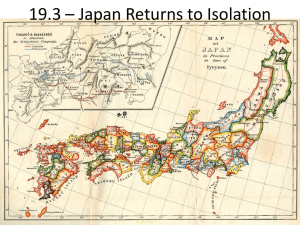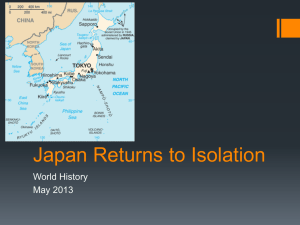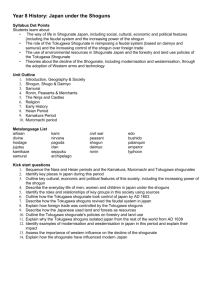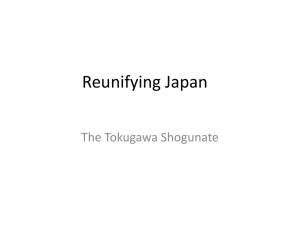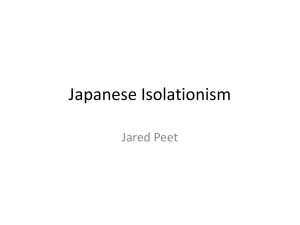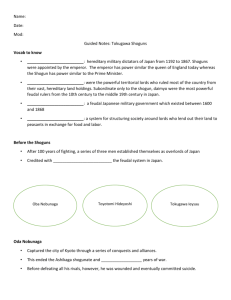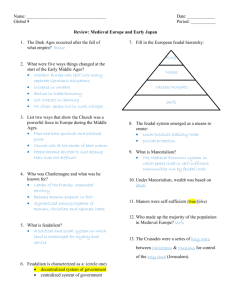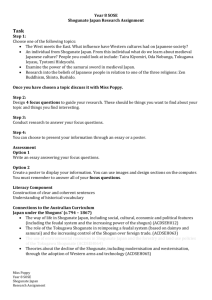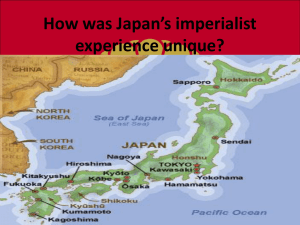UCLMUN V 2015 * Crisis Study Guide
advertisement
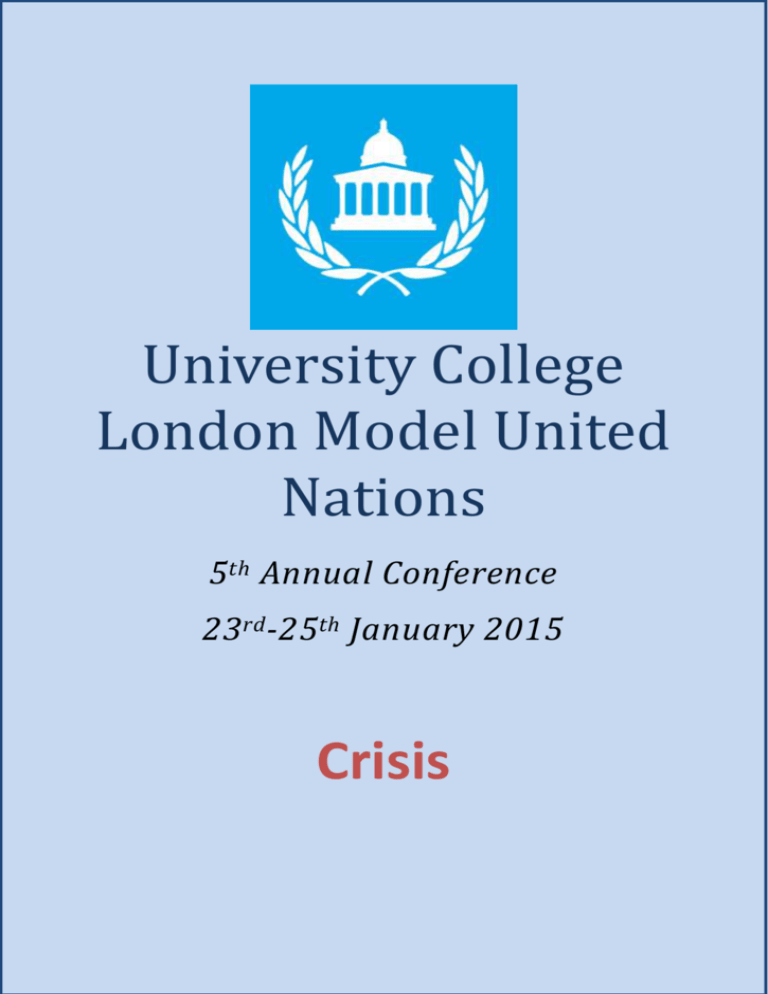
University College London Model United Nations 5th Annual Conference 23rd -25th January 2015 Crisis UCLMUN V 2015 – Crisis Study Guide 23rd – 25th January 2015 Table of Contents Introduction: Letter from the Directors......................................................................................... 3 THE TOKUGAWA SHOGUNATE (JAPAN)......................................................................................... 4 General Information and History ..................................................................................................... 4 Maps of the Tokugawa Shogunate ................................................................................................... 6 Political ............................................................................................................................................ 6 Topographical ................................................................................................................................. 7 Provincial......................................................................................................................................... 8 Government and Politics ................................................................................................................ 10 The Imperial Court ........................................................................................................................ 10 The Bakufu .................................................................................................................................... 11 The Military .................................................................................................................................... 13 The Army ....................................................................................................................................... 13 The Navy ....................................................................................................................................... 14 The Economy .................................................................................................................................. 16 Points to Consider for the Tokugawa Shogunate in ‘The Rising Sun’ ............................................. 18 THE UNITED STATES OF AMERICA......................................................................................... 19 General Information and History ................................................................................................... 19 Maps of the United States of America ........................................................................................... 21 Political .......................................................................................................................................... 21 Topographical ............................................................................................................................... 22 Territorial Acquisitions (1803-53) and Manifest Destiny .............................................................. 23 1860 Election Results .................................................................................................................... 24 Free States v. Slave States............................................................................................................. 25 Government and Politics ................................................................................................................ 26 The President and his Cabinet ...................................................................................................... 26 The Military .................................................................................................................................... 28 The Army ....................................................................................................................................... 28 The Navy ....................................................................................................................................... 29 The Economy .................................................................................................................................. 30 Points to Consider for the United States of America in ‘The Rising Sun’ ....................................... 32 2 UCLMUN V 2015 – Crisis Study Guide 23rd – 25th January 2015 Introduction: Letter from the Directors Dear Delegates, It is with great pleasure and excitement that we – the Directors – welcome you to the Crisis at UCLMUN 2015! This year’s Crisis, entitled ‘The Rising Sun’, will see you all thrown into the worlds of Japan and America in the 1860s. Historically, this was a time when both countries were racked by enormous change, some of which developed over time and some of which happened almost over night. The crisis will start on November 6th 1860. Your job as delegates will be to navigate and survive these rough waters whilst aiming to achieve these objectives: 1. Modernize the economy and technology of Japan; 2. Resolve the political and social tensions in each other’s countries; 3. Establish an effective means of tackling European influence in Asia. How you achieve these goals is completely up to you. There are also other ‘Points to Consider’ which are enclosed in this study guide, and can be topics for discussion in your respective cabinets if you have a quiet moment (which we doubt!). This study guide will provide you with all the essential details you need to know in the run-up to – and duration of - this Crisis, and we hope it serves you well in the arduous (yet fun!) times ahead. Being a historical Crisis, we feel that you will all be given an equally fair challenge, regardless of your previous experience as delegates or which cabinet you may be in. You will not only be tested on your understanding of the complex history and societies both these nations possess, but also whether you will be able to use skills such as diplomacy and negotiation, or are prepared to use your cunning and take risks, in order to maintain – or perhaps completely alter – the course of history. Should you have any questions or concerns in the run-up to the Crisis this year, you are more than welcome to contact us at uclsun@gmail.com. We will try and respond to your inquiries as quickly as possible. With excitement in travelling back to 19th century Japan and America with you all, Maurice Kirschbaum Head Director Eugenia Caracciolo-Drudis, Kyle Tinga and Kyle Jordan Deputy Directors 3 UCLMUN V 2015 – Crisis Study Guide 23rd – 25th January 2015 THE TOKUGAWA SHOGUNATE (JAPAN) General Information and History Flag Capital Language Religion Government Population Gross Domestic Product (GDP) GDP per Capita Currency Currency Value Seal Edo (Tokyo) Japanese (Official); English, Dutch, Chinese, Korean (Spoken) Shintoism (Official); Buddhism, Christianity (Practiced) Feudal Military Dictatorship Emperor – Emperor Kōmei Shogun – Tokugawa Iemochi Tairō – Andō Nobumasa 29,627,142 (estimate) $20,739,000 (estimate)1 $700 (estimate)2 Ryō 1 Ryō = ¥4000 = $33.70 (in 2014) The Tokugawa Shogunate was the last feudal Japanese Military Government, established in 1603 by Tokugawa Ieyasu, who ruled from his castle in Edo (present day Tokyo), a tradition which his successors continued. The head of the nation’s government was the Shogun, a hereditary military governor, and from 1603-1868 they were all members of the Tokugawa Clan, although this system had been in place since 1192. During the 1500s, power was decentralized in Japan, which was torn apart by warfare between competing feudal lords (Daimyo) for nearly a century. Following his victory in the Battle of Sekigahara in 1600, however, Tokugawa Ieyasu (1543-1616) swiftly consolidated power. The largely powerless Imperial Court then named Ieyasu as Shogun in 1603, beginning a dynasty that would rule Japan for close to two-and-a-half centuries. 1 No GDP figures for Japan exist between 1821-1869, so this is a rough estimate between figures recorded in 1820 and 1870. 2 See above. 4 UCLMUN V 2015 – Crisis Study Guide 23rd – 25th January 2015 From the beginning, the Tokugawa regime focused on reestablishing order in social, political and international affairs after a century of warfare. The political structure, established by Ieyasu and solidified under his two immediate successors, his son Tokugawa Hidetada (ruling from 1616-23) and grandson Tokugawa Iemitsu (1623-51), bound all Daimyos to the Shogunate and limited any individual Daimyo from acquiring too much land or power. Suspicious of foreign intervention and colonialism, the Tokugawa regime acted to exclude missionaries and eventually issued a complete ban on Christianity in Japan. Near the beginning of the Tokugawa period, there were an estimated 300,000 Christians in Japan; after the Shogunate’s brutal repression of a Christian rebellion on the Shimabara Peninsula in 1637-38, Christianity was forced underground. The dominant faith of the Tokugawa period was Shintoism, a relatively conservative religion with a strong emphasis on duty and purity. In its efforts to close Japan off from damaging foreign influence, the Tokugawa Shogunate also prohibited trade with Western nations and prevented Japanese merchants from trading abroad. With the Act of Seclusion (1636), Japan was effectively cut off from Western nations (with the exception of a small Dutch outpost in Nagasaki Harbour). At the same time, it maintained close relations with neighboring Korea and China, confirming a traditional East Asian political order with China predominantly at the centre. This all changed in 1854, however, when Japan signed the Convention of Kanagawa with Commodore Matthew C. Perry of the United States Navy, which opened the Japanese ports of Shimoda and Hakodate to American trade, along with establishing a US Consul in the former. In 1858, the US Consul to Japan, Townsend Harris, negotiated a second trade treaty with the Japanese (known as the Treaty of Commerce or Harris Treaty) which – along with continuing the arrangements of Shimoda and Hakodate - opened the ports of Yokohama, Nagasaki, Niigata and Kobe to American trade. Furthermore, US Citizens were to be allowed to reside in all the trade ports listed, erect and/or purchase their own houses and buildings, as well as allow them the right of religious expression, thereby circumventing the Shougunate’s ban on Christianity in those ports. As of November 6th 1860, Japan has seen some (yet ultimately very little) positive economic impact from its trade with America and other western nations, and has even gone on to establish its first official Embassy in San Francisco. However, there have been growing political and social troubles in the wake of this: the Shogun – presently Tokugawa Iemochi – has seen his political position weakened due to the old international and religious policies being broken, and the American government’s habit of negotiating with the ceremonial Emperor – presently Emperor Kōmei – and the Imperial Court rather than with him himself. At the same time, the increase of foreign – particularly American – immigrants living in the country has upset both the old samurai and the more modern artisan (trade) classes, the former who feel that the old traditions of the country are being destroyed by the foreigners presence, while the latter complain they are being unfairly outcompeted due to the terms of the Commerce Treaty of 1858. There have been many episodes of brutal violence across the nation, and this has actually led to the deaths of several government officials. Historically, the Shogunate eventually crumbled, with the Emperor and the Imperial Court gradually eclipsing the Shogun and his Daimyos in terms of power and strength. The short yet decisive Boshin War (1868-69) saw the official end of the Shogunate, with all powers returned to the Emperor – now Emperor Meiji – who would then enact what is now known as the Meiji Restoration, which among 5 UCLMUN V 2015 – Crisis Study Guide 23rd – 25th January 2015 other things saw the breaking down of the feudal order of Japan. A last ditch attempt at preserving the rule of the Tokugawa in the form of the Republic of Ezo on the northernmost island of Hokkaido quickly fell within a year, and as of 1870 the Empire of Japan was officially born. Whether Japan falls to the same fate, or goes down a completely different path, is entirely up to you and your actions. Maps of the Tokugawa Shogunate Political3 Can be viewed in a higher resolution by clicking here. 3 Although this is a modern political map, most present day cities existed during the Edo period, and only a few were renamed (e.g. Tokyo) 6 UCLMUN V 2015 – Crisis Study Guide 23rd – 25th January 2015 Topographical 7 UCLMUN V 2015 – Crisis Study Guide 23rd – 25th January 2015 Provincial 8 UCLMUN V 2015 – Crisis Study Guide 23rd – 25th January 2015 Names of Provinces (by Number) 1) 2) 3) 4) 5) 6) 7) 8) 9) 10) 11) 12) 13) 14) 15) 16) 17) 18) 19) 20) 21) 22) 23) 24) 25) 26) 27) 28) 29) 30) 31) 32) Hokkaido Dewa Mutsu Echigo Shimotsuke Hitachi Kazusa Shimosa Awa Musashi Kozuke Sagami Izu Suruga Kai Shinano Totomi Mikawa Owari Mino Hida Etchu Noto Kaga Echizen Omi Ise Iga Shima Kii Yamato Yamashiro 33) 34) 35) 36) 37) 38) 39) 40) 41) 42) 43) 44) 45) 46) 47) 48) 49) 50) 51) 52) 53) 54) 55) 56) 57) 58) 59) 60) 61) 62) 63) 64) 9 Kwatchi Izumi Settsu Tamba Wakasa Tango Tajima Harima Inaba Mimasaka Bizen Bitchu Bingo Hoki Izumo Iwami Aki Suo Nagato Sanuki Awa Tosa Iyo Bungo Buzen Chikuzen Hizen Chikugo Higo Hyuga Osumi Satsuma UCLMUN V 2015 – Crisis Study Guide 23rd – 25th January 2015 Government and Politics The Government of the Tokugawa Shogunate was a feudal military dictatorship. The Head of State was the Emperor, whose role was mostly ceremonial, though when it was necessary to do so it was his duty to choose a Shogun (literally meaning ‘General’ or ‘Field Commander’), however this had not happened since the Tokugawa’s came to power in 1603. The Shogun was the Head of Government, and held – for most of the Edo Period – the greatest amount of political power in Japan. Not only did he control the Armed Forces; he also enacted domestic and foreign policy, appointed his own ministers and was even able – in some cases – to grant land to or revoke land from the Daimyos, the feudal lords of Japan. Almost unique to the politics of Japan at the time, both the Emperor and the Shogun had their own ‘cabinets’. Contrary to being a unified system, the two ‘cabinets’ – the Emperor’s Imperial Court and the Shogun’s Bakufu (meaning ‘House of the General’ or ‘Tent of the General’) – operated separate to one another, and only consulted one another when they deemed necessary. In the later periods of the Edo period, this was almost always the case, due to foreign governments negotiating directly with the Imperial Court, either because they mistook it as the centre of political power in Japan, or because they deliberately ignored the feudal system which the Shogun controlled. The Imperial Court The Imperial Court, which was based in the city of Kyoto, was made up of two separate bodies within itself: The Daijō-kan (Council of State) and the Eight Ministries. The former was responsible for the actual supervision of the Imperial Court and supervising the relations between the Emperor and the Daimyos, while the latter effectively acted as a ‘shadow cabinet’ to the Shogun and his Bakufu, eventually gaining actual power in the late Edo period. The Eight Ministries were as follows: 1) Ministry of the Centre (Nakatsukasa-shō) – Responsible for the Emperor and access to him. 2) Ministry of Ceremony (Shikibu-shō) – Graded the performance of civil servants, recommended their appointments and awards; decided their ceremonial seniority and privileges. 3) Ministry of Civil Administration (Jibu-shō) – Responsible for ceremonial aspects of the Imperial Year, of ceremonial encounters with foreign nations (e.g. state visits), and overseeing the maintenance of Imperial tombs and mausoleums. 4) Ministry of Popular Affairs (Minbu-shō) – Responsible for observation of the general populace. 5) Ministry of Defence / War (Hyōbu-shō) – Responsible for the actual upkeep and logistics of the Armed Forces. 6) Ministry of Justice (Gyōbu-shō) – Responsible for the administration of trials, the determining of punishment and their imposition. 7) Ministry of the Treasury (Ōkura-shō) – Responsible for the regulation and control of the economy and industry. 8) Ministry of the Imperial Household (Kunai-shō) – Responsible for the care of the entire Imperial Family, their possessions and land. 10 UCLMUN V 2015 – Crisis Study Guide 23rd – 25th January 2015 Despite not holding any actual power for the majority of the Tokugawa / Edo period, the Imperial Court had the edge of having quite a lot of formidable civil servants in its service, who were able to formulate practical policies while not actually having to shoulder any real responsibility due to the dominance of the Shogun and his Bakufu. When that dominance began to crumble in the later years of the Tokugawa / Edo period, the Imperial Court was able to impress and win over many foreign governments and local Daimyos alike with its expertise and proposed policies, hence why the Meiji Restoration achieved much success in the 1870s historically. The Bakufu The Bakufu, which was based in the city of Edo, functioned a lot more simply (yet elusively) in relation to the Emperor’s Imperial Court. In theory, the name Bakufu (‘Tent of the General’ or ‘Tent Governance’) implies that its authority was only temporary. In reality, the Bakufu held most of the political power for the vast majority of the Edo period. With the Shogun at its head, only two other forms of position existed in the Bakufu: 1) Tairō – Meaning ‘Great Elder’, the role was usually filled by the Shogun’s most trusted ally and statesmen. Second only to the Shogun himself, the Tairō was chiefly responsible for assisting the Shogun in carrying out his policies and making sure they went smoothly, while also representing him at important events where he cannot be present, as well as maintaining the loyalty of fellow Daimyo’s and keeping the rest of the Bakufu in line. 2) Rōjū – Meaning ‘Elder’, there were usually up to four or five Rōjū at a time in the Bakufu (although the number was not fixed, and the Shogun could have as many or as little as he pleased). Each Rōjū could either be given a separate responsibility by the Shogun or they could be tasked with working together on issues. Generally, the Bakufu consisted of Daimyos (particularly those the Shogun wanted to keep good relations with). This in mind, it is worth considering that on-top of their responsibilities as members of the Bakufu, they were still responsible for the local administration of their respective provinces. This could sometimes work to their benefit, if their province was large and important enough that they could use its status in order to improve their own standing in the Bakufu. At the same time, there could be detrimental effects, particularly if the populace of a particular province began to feel marginalized or even full-out ignored by their Daimyo. That said, the Bakufu could sometimes consist of members of the Shogun’s own family, if he so willed it. Since the start of 1860, the Bakufu has struggled under the burden of poor economic policies which have failed to take any real nationwide benefit from the trade with America (See: Economy), and recent political turmoil: the Tairō Ii Naosuke, who was able to make himself present at the signing of the Commerce Treaty due to his formidable diplomatic skill – and who looked to be the man able to fix the Bakufu’s problems – was assassinated by an unknown group of assailants outside the very gates of Edo in March 1860. Those loyal to the Shogun say the Imperial Court was to blame, despite the fact that it vehemently denied any involvement. 11 UCLMUN V 2015 – Crisis Study Guide 23rd – 25th January 2015 Diagram of the Governance of the Tokugawa Shogunate (1860) The Emperor Emperor Kōmei The Shogun Tokugawa Iemochi The Imperial Court The Bakufu Council of State Daijō-kan The Tairō Andō Nobumasa The Eight Ministries The Daimyo Feudal Lords The Samurai Knights Farmers and Artisans Merchants and Craftsman Peasants Key The Emperor and His Court The Shogun and His Bakufu The Japanese Feudal System (Italics denote European equivalent) Direct Connection Theoretical Connection Exertion of Influence Forms apart of / can be appointed to… 12 The Rōjū UCLMUN V 2015 – Crisis Study Guide 23rd – 25th January 2015 The Military Pre-Meiji Restoration, the numbers and organization of the Japanese Armed Forces (which hadn’t even been officially formed yet) was – despite being a military dictatorship – incredibly vague. Due to the fact that most of the Shogunate was still feudal, it employed feudal doctrine. When called upon, Daimyos would raise their banners in support of the Shogunate and spare all the men and resources they could towards the war effort. Due to the fact that there was no set limit as to how many men and resources they had to give (just ‘as many as they could spare’), the numbers are never solid, particularly if a Daimyo – for whatever reason – decided to hold men and resources back. It’s also worth considering that, ever since the Tokugawa Shogunate was established in 1603, the island had seen very little conflict or bloodshed. The samurai, who were historically the warrior class of the realm (the knights, if you will), had – by the late Edo period of the 1850s – become more of an administrative and bureaucratic class, with very few actually remembering the ways of their ancestors. As of November 6th 1860, active diplomacy with the United States and other western nations gives you the opportunity to build and modernize your Armed Forces, therefore giving you much more solid troop numbers and giving you a much more effective fighting force, with modern weapons and training. You may have to expect a heavy price in return for all this aid, however, unless you give either America or the other western nations (the British, the Dutch and the French) a good enough reason to help you for free. Command is traditionally left directly to the Shogun, who will then appoint his own chosen field commanders if he is not leading directly himself. However, the Imperial Court’s Ministry of Defence / War has taken on greater responsibility come the late Edo period, with being chiefly responsible for the continued supply of troops while they’re raised as well as maintaining equipment and – wherever possible – pursuing modernization policies in provinces where their Daimyos will allow it. The Army As mentioned above, the army during the Tokugawa / Edo era (as it had been before then) was predominantly a levy raised from the holdings of the Daimyos, who would rally to the Shogun in times of war for him to lead them. Numbers could vary from conflict to conflict, depending on how dangerous the enemy was or how serious the Daimyos personally deemed the conflict to be and / or 13 UCLMUN V 2015 – Crisis Study Guide 23rd – 25th January 2015 whether it worked to their benefit for the Shogunate to be weakened so that they could use their forces for other means later on. The only true professional soldiers were the Samurai, and those that otherwise served acting as guards and policemen in the holdings. Taking the average of total troops raised during times of war or crisis just before, during and after the Edo period, it is reasonable to assume that the Shogunate (as a whole), was able to raise around 160,000 professional troops, with the possibility of more conscripted, less well trained troops if the need called for it. The professional troops would mostly be armed with feudal battle gear (swords, pikes, spears, bows, crossbows etc.), though despite the technology being old this did not make them any less lethal to a more modern army of the time. Conscripted troops may be lucky enough to be equipped with similar items, but in dire situations could be expected to use anything so long as it could kill or maim. Following contact with America and other western nations, the forces of Japan slowly began to westernize, though as of November 6th, 1860 that was only the case in certain holdings – particularly the provinces of Satsuma, Nagato, Hizen, Tosa and Kaga, as well as the province of Yamashiro (where Kyoto, and thus the Emperor and Imperial Court, is located) – due to the continuing feudal political system and foreign reluctance to negotiate with the Shogun, instead choosing to negotiate with the Emperor (whose court setting was at least somewhat familiar to them). The more modern soldiers are few in numbers – as of 1860 only numbering some 5000 men – but they are equipped with the most up-to-date technology (rifles, revolvers, howitzer guns, even some very early prototypes of Gatling guns) and have been trained by seasoned western officers. The Navy Due to the fact that most of the military engagements the west had with Japan in the 1600s-1800s were naval, we have a lot more solid numbers for the Navy than we do the Army. Just like armies, the Daimyos were able to raise their own individual provincial navies, and would contribute them to a war effort if the Shogun called on them. Unlike the armies, however, the modernization process of the Navy started much earlier, with Japanese naval technicians being tasked with taking notes on the ships of the Dutch that had been sailing in and out of Nagasaki since 1600. Following the devastating defeat dealt to China in the First Opium War (1841-42) by the British, the Japanese prioritized the modernization of their Navy even more and began to take more inspiration from the British Royal Navy rather than the Dutch. By the 1860s, the Shogun himself could raise a fleet of eight screw-driven steam warships and thirtysix auxiliary (supply and transport) sail ships. The Daimyos could also raise their own individual navies, as previously mentioned. Those that westernized the fastest, such as Satsuma (which could raise nine steam warships and forty auxiliary sail ships) and Nagato (five steam warships, thirty auxiliary), as well as Kaga (ten steam warships) and Chikuzen (eight steam warships) were in some ways the most beneficial to the Shogunate in times of naval importance, but also the most threatening. The problem the young Japanese Navy still faced, however, were that most of its sailors were untrained and were just conscripted merchant sailors, and therefore were not prepared for battle if 14 UCLMUN V 2015 – Crisis Study Guide 23rd – 25th January 2015 the need arose (which it did, on several occasions). Furthermore, most of the new ships were imported, which was not only a drain on the already unstable economy but also meant in some cases that their quality was not perfect, due to foreign contractors getting lazy with their orders or simply not rating the Shogunate with enough importance to put their best quality work into it. 15 UCLMUN V 2015 – Crisis Study Guide 23rd – 25th January 2015 The Economy The Japanese economy grew significantly during the early years of the Tokugawa period. In addition to an emphasis on agricultural production (including the staple crop of rice as well as sesame oil, indigo, sugar cane, mulberry, tobacco and cotton), Japan’s commerce and manufacturing industries also expanded, leading to the rise of an increasingly wealthy merchant class and in turn to the growth of Japanese cities. When military Japan settled down to a life of peace in the early 1600's, it was possible for trade to grow to proportions previously unknown. In peace there was also less reason for local commercial restrictions, so that even though the country was still divided into the many domains of individual lords, the tendency was for the whole to become one economic unit. The official and aristocratic populace of government officials created a demand for goods and services which only the artisans could furnish. In this circumstance the relatively simple rice economy of the individual feudal domain gradually gave way to a money and credit economy managed by merchants, brokers, and bankers, who controlled the rice markets and storehouses of great cities such as Osaka and Edo. Throughout the Tokugawa period the power of the trader artisans grew to the point where it could exploit the samurais and farmer artisans and there were two reasons for this: First was the further development of Edo as a large city which had to be supplied in part by importing food and which demanded a large supply of manufactured luxuries. Secondly, the samurai, by reason of their new consumptive habits, became more and more dependent on the merchant. Once a taste of luxury was acquired, the nobility was prepared to mortgage its future to the merchant rather than be surpassed in conspicuous consumption by their neighbors. Japanese farming had changed very little over the centuries and during the Tokugawa period it shifted from cooperative enterprises to individual farms. Thereby the exchange of goods became less a matter of social or ritual obligation and more of a question of whether the price was right. By 1700, Japan had not only modified its economy, but had also acquired in its larger cities a growing and prosperous middle class. The Tokugawa period saw the beginnings of prolonged struggles between a rice agriculture and industry, between a local barter economy and a national money economy, between a feudal and military aristocracy and the power of commercial and then industrial capital and between the food supply and the growing population that had to be fed. Agro-productivity was declining and there was much agrarian distress from taxation, usury, flood, drought, and price fluctuations. By the end of the Tokugawa period there was a growing class of prosperous farmers. For the first half of the Tokugawa period population increased rapidly. This initial increase bore heavily on the food supply and the growth of cities contributed to a severe labor shortage in the 16 UCLMUN V 2015 – Crisis Study Guide 23rd – 25th January 2015 rural areas. The stability of the Shogunate was also undermined by its failure to pursue sound policies in public finance. While the state was organized in a feudal pattern, the Bakafu derived regular revenue from its personal domains only. The consequence was a state of chronic deficit relieved little from the drastic economic policies enacted at the time. Because of the political organization of the country there was no access to national loans, and the coinage was in a constant state of devaluation. By the 1830's the once secure Tokugawa Shogunate was in a serious crisis. The failure of the government to ease the burden of the peasantry was dramatized by a rebellion in 1837 within the official ranks. A minor official in Osaka encouraged the peasants and urban workers to rise up and kill heartless officials and corrupt merchants. This proved to be a minor flare up and was quickly suppressed, but it was symptomatic of popular resentment toward central authority. The opening of Japan to uncontrolled foreign trade following the Treaty of Commerce in 1858 also brought with it massive economic instability. While some entrepreneurs (particularly American entrepreneurs) prospered, many others (mostly traditional artisans) went bankrupt. Unemployment rose, as well as inflation. Coincidentally, major famines also increased the price of food drastically. Incidents occurred between brash foreigners, qualified as "the scum of the earth" by a contemporary diplomat, and the Japanese. Japan's monetary system, based on Tokugawa coinage (the ryō, pictured right), also broke down. Traditionally, Japan's exchange rate between gold and silver was 1:5, whereas international rates were of the order of 1:15. This led to massive purchases of gold by foreigners, and ultimately forced the Japanese authorities to devalue their currency. There was a massive outflow of gold from Japan, as foreigners rushed to exchange their silver for "token" silver Japanese coinage and again exchange these against gold, giving a 200% profit to the transaction. In the early months of 1860, about 4 million ryōs thus left Japan, which is about 70 tons of gold. This effectively destroyed Japan's gold standard system, and forced it to return to weight-based system with International rates. The Bakufu instead responded to the crises by debasing the gold content of its coins by two thirds, so as to match foreign gold-silver exchange ratios. With inflation and unemployment continuing to rise, the Shogunate has two key options: adopt a new currency, and / or re-negotiate the trade treaties with America and the west. Both are possible, although the latter is – truth be told – highly hopeful of a charitable nature. 17 UCLMUN V 2015 – Crisis Study Guide 23rd – 25th January 2015 Points to Consider for the Tokugawa Shogunate in ‘The Rising Sun’ To briefly summarize all the information before this point up in a single sentence: the situation of the Tokugawa Shogunate as of November 6th, 1860 is a dire one. The economy is beginning to suffer from years of mismanagement on top of the unbridled trade coming in from America and the West. The political and social situations are also pretty tense, with little communication between the Imperial Court and the Bakufu while each slowly encroach on the other’s powers. The people are also getting restless, with rising unemployment and inflation leading to famine and increases in poverty, while suspicion and mistrust of American and other foreign immigrants (along with violence against them) is at an all-time high. The military is starting to modernize; though due to the lack of any real central planning it’s seemingly not going fast enough. All that in mind, it is suggested that the Tokugawa Shogunate consider and aim to tackle (and perhaps resolve) these issues during ‘The Rising Sun’ Crisis: The Economy: Cutting inflation and dealing with unemployment, as well as perhaps reviewing the currency. The trade agreements with America and the west are heavily onesided, but whether you’ll be able to re-negotiate them will probably depend on how long it takes to eventually get them to concede that. Politics and the Feudal System: There’s no denying that there needs to be more communication between the ‘branches’ of the Japanese government and that they have to act more in unison, but how prepared are you all to work together? After all, some of you gain more in certain situations where others might not. As for reform? That could be even more difficult. Immigration and Cultural Issues: The increase of westerners now living in Japan and the reintroduction of Christianity to the public following its long-term ban has led to some form of ‘cultural shock’, particularly amongst veteran samurai and hardline Shinto followers. With the problem becoming ever more increasingly violent, how much longer can you wait until you have to get directly involved? Modernization of the Military: How are you going to continue the modernization of the military, if at all? Will you want to focus on another area? Will you create actual military branches instead of relying off the old feudal system, and if so, who will be responsible for them? How many powers do you think Daimyos will allow you to take away from them? European Influence in Asia: On the one hand, European influence in Asia is a threat to you and the Shogunate, for if European powers are prepared to pick China apart, what’s to stop them from going for you? At the same time, the technology Europe offers is just as advanced as the United States, and if they start to become unresponsive to you, Europe might be your only hope of actually modernizing your economy and technology. 18 UCLMUN V 2015 – Crisis Study Guide 23rd – 25th January 2015 THE UNITED STATES OF AMERICA General Information and History Flag Seal Capital Language Religion Government Population Gross Domestic Product (GDP) GDP Per Capita Currency Currency Value Washington D.C. English (Official) Christianity (Various sects practiced)4 Federal Presidential Constitutional Republic President-elect – Abraham Lincoln Vice President-elect – Hannibal Hamlin Speaker of the House – William Pennington Chief Justice – Roger B. Tanney 31,443,321 (3,953,761 of whom are slaves) $69,346,000 $2,178 United States Dollar (USD / $) $1 (in 1860) = $26.60 (in 2014) Upon achieving independence from the United Kingdom in 1783, the thirteen states which formed the United States of America found themselves surrounded by a very harsh world, but that did not intimidate them. With their own constitution they created a framework for modern democratic governance, the organs of power completely separate from each other in order to ensure that the newborn nation did not succumb to the type of tyranny they once suffered beneath their British overlords. The President, rather than being the sole leader of the nation, was its figurehead and guiding hand; a person for the people to rally behind in times of crisis, hardship and war. From 1803-53, the expansionist ideas of Manifest Destiny saw the United States grow from the East Coast to the West, some of which was guaranteed in purchases from other states, but some of which was gained through war and conquest. A second war with the United Kingdom from 1812-15 4 The United States does not have an official religion due to the constitutional guarantee for freedom of religious expression, but Christianity is by far the largest practice. 19 UCLMUN V 2015 – Crisis Study Guide 23rd – 25th January 2015 hardened the American identity, and despite Washington D.C. being sacked, America did not falter and was able to retain its sovereignty. For a long time afterwards, the war was remembered as a “Second War of Independence”. American patriotism continued to be high, even in the newly acquired territories. Seeds of industrialization were planted in the 1850s, particularly after the Gold Rush in California in 1848. The United States became a country of entrepreneurs, looking to make a decent living and earn large sums of money. People from all over the world who shared the same sentiment came in their thousands as immigrants, looking to make a new life in the New World. This meant that America never found itself short of skilled laborers, or even just extra hands. As of November 6th, 1860 however, the “Land of the Free” has been struggling to hold itself together. Despite a very prosperous economy, harsh treatment towards Native American tribes – with forced relocation throughout the 1830s – has seen once mighty tribes felled by malnutrition and disease. Furthermore, the political situation is reaching boiling point. President-elect Abraham Lincoln’s ambitions of banning the use of black slaves in the United States – following the example of other western nations – has caused uproar in the Southern states, who claim that the tyranny of the North is impeding on their State rights. What’s more troublesome is that, throughout the entirety of the 1860 election year, there have been murmurings of secession, and now that Lincoln has won this seems all the more likely. Currently in his hometown of Springfield, Illinois, the new President and his new cabinet will have to work together in order to try and prevent secession – if it is even possible at this point – or upon failing that they must prepare for war against their own brothers, something which up to that point had been considered unimaginable in the United States. However, that’s not the only issue the new President and his cabinet have on their plates. The ideals of Manifest Destiny have spread far beyond the present borders, and have now taken the form of increasing global American influence. Confrontations with European powers in the Caribbean as well as East Asia in the Pacific are quite common, and as America continues to grow it is looking for allies in order to help them in their goals. In Asia, America has found a suitable ally in Japan, one of the few Asian states still free of European colonial influence. If America can exert its own influence there, it will then have a suitable safe zone from where they can then confront European colonialism in Asia, inspiring movements of independence in countries that suffer like they used to. In order to achieve this, however, America will need to maintain an active presence in Japan, while at the same time the Japanese islands will have to maintain some form of political stability. Historically, America maintained its commitments in Japan despite the Civil War raging on at home, though there was definitely a significant drop in the volume of trade being conducted and actual communication between both nations fell quiet, leading to Japan entering talks with other European powers – particularly the British and the French – which undermined American efforts there and meant that its ambitions of inspiring independence movements in Asian countries could not be realized for a considerable number of years. Failure to maintain any proper presence in Japan will mean that the President and his cabinet will have failed Manifest Destiny, which will not do much to install confidence in the people of the United States, particularly because they hinge their identities on it so much. Whether America is more successful in keeping a presence in Japan, and whether it even goes through Civil War at all and instead continues on the way it has up to this point, depends completely on how you deal with the situation. 20 UCLMUN V 2015 – Crisis Study Guide 23rd – 25th January 2015 Maps of the United States of America Political 21 UCLMUN V 2015 – Crisis Study Guide 23rd – 25th January 2015 Topographical 22 UCLMUN V 2015 – Crisis Study Guide 23rd – 25th January 2015 Territorial Acquisitions (1803-53) and Manifest Destiny 23 UCLMUN V 2015 – Crisis Study Guide 23rd – 25th January 2015 1860 Election Results 24 UCLMUN V 2015 – Crisis Study Guide 23rd – 25th January 2015 Free States v. Slave States 25 UCLMUN V 2015 – Crisis Study Guide 23rd – 25th January 2015 Government and Politics When the Founding Fathers were writing the US Constitution, they wanted to create a system of governance that would ensure no single individual or group of people – not then or in the future – would ever be able to hold enough power to have an effective tyranny over the American people. That is why, to the present day – and with very little alterations since 1783 – the organs of state (the executive, the legislature and the judiciary) are completely separate from one another. For an example of how this works: unlike the Prime Minister of the UK – who has to be elected into the House of Commons in order to be PM – the President is elected separately to Congress. What this means in the grand scheme of things, however, is that all of the organs of state are required to cooperate with one another and work together in order to solve issues, instead of just one individual making most of the decisions, and keep oversight over one another through a system of checks and balances. Even though the President is the Head of State, he’s not the sole authority. In addition to this, there are three general levels to governance in the United States: federal, state and local. The States of the Union are, in effect, their own sovereign entities – this means that they can enact their own laws and policies, so long as they do not infringe upon the rights guaranteed by the Constitution (e.g. no State would be allowed to ban freedom of religious expression, or illegalize the ownership of guns). The federal government acts as an oversight of all the States, whom themselves send representatives to the Congress. In effect, the only things the federal government is responsible for are: the expenditure of the Union, the defence of the Union and administration of the Territories, which sooner or later will become States as well. This is why, as of November 6th, 1860, many southern states are threatening to secede: they see Lincoln’s campaign promise of abolishing slavery as infringing on their state rights, and evidence their belief that the northern Free States are trying to enforce their ideals upon the South. Since the turn of the 19th century, there have been two primary parties in American politics (although more do exist): the Democratic Party and the Republican Party. The newly elected President, Abraham Lincoln, is a Republican. The President and his Cabinet President-Elect Abraham Lincoln, who has yet to be officially inaugurated, is currently situated in Springfield, Illinois with his chosen Cabinet members. The Cabinet is made up of unelected officials whom the President-Elect has personally chosen to help aid him in producing legislation for the benefit of the Union. As of November 6th, 1860, the Cabinet is made up of the following offices: 26 UCLMUN V 2015 – Crisis Study Guide 23rd – 25th January 2015 1. The Vice-President: The President’s closest advisor, he is officially the President of the United States Senate, and therefore usually sits there during sessions and votes on the Cabinets behalf, although it is just a single vote. He is the first in the line of presidential succession. 2. Secretary of State: Second in the line of presidential succession, the Secretary of State is responsible for advising the President on foreign policy while also overseeing and coordinating the actions of the United States in other countries. 3. Secretary of War: Third in the line of presidential succession, the Secretary of War is chiefly responsible for the United States Army, while also advising the President on military matters. He is also responsible for the supply and maintenance of the United States Armed Forces. 4. Secretary of the Navy: Fourth in the line of presidential succession,5 the Secretary of the Navy is responsible for the United States Navy, working in liaison with the Secretary of War. 5. Secretary of the Treasury: Fifth in the line of presidential succession, the Secretary of the Treasury is responsible for advising the President on fiscal policy and government spending. Your signature is required on every dollar note in order to make it legal tender. 6. The Attorney General: Sixth in the line of presidential succession, the Attorney General is responsible for advising the President on legal matters and proceedings. He is also referred to as “The President’s lawyer”, and usually does represent him in legal matters unless he is directly required. 7. Secretary of the Interior: Seventh in the line of presidential succession, the Secretary of the Interior is responsible for the administration for the Territories, as well as general Land Management and overseeing National Reserves. The Secretary of the Interior is also heavily involved in dealing with the issue of Native Americans and their settlements. 8. Postmaster General: Eighth in the line of presidential succession, the Postmaster General is responsible for, as the name implies all postal communication in the United States. This also included communication via telegram. 5 This would actually be the President pro Tempore, who is the most senior member of the Senate, but for the purposes of this Crisis we’re putting the Secretary of the Navy in his place. 27 UCLMUN V 2015 – Crisis Study Guide 23rd – 25th January 2015 The Military The history of the U.S. Military dates to 1775, even before the Declaration of Independence marked the establishment of the United States. The Continental Army, Continental Navy, and Continental Marines were created in close succession by the Second Continental Congress in order to defend the new nation against the British Empire in the American Revolutionary War. These forces demobilized in 1784 after the Treaty of Paris ended the War for Independence. The Congress of the Confederation created the United States Army in 1784, and the United States Congress created the United States Navy in 1794 and the United States Marine Corps in 1798. The 1787 adoption of the Constitution gave the Congress the power to "raise and support armies", "provide and maintain a navy", and to "make rules for the government and regulation of the land and naval forces", as well as the power to declare war. The United States President was made the U.S. military's commander-in-chief. Following the War of 1812 and Mexican-American War (1846-48), the United States Armed Forces has become a force to be reckoned with, holding its own against several world powers. It has also created a lot of experienced officers and commanders, some of whom are common household names: Ulysses S. Grant, Robert E. Lee, David Farragut, Raphael Semmes and many more. The experience of war also caused the US Armed Forces to keep itself consistently up-to-date in terms of equipment and supplies. However, as of November 6th 1860, a crisis facing the United States Armed Forces is the question of loyalty in the ranks. With the states of the North and South trading hot words with one another, the potential for soldiers and officers alike from those particular states to put their State’s interests ahead of those of the Union is at an all-time high, and if a Civil War is looming, it can only take place with forces for both sides… The Army As of November 6th, 1860, the United States Army is a seemingly miniscule 16,000 trained men and officers; however it should be acknowledged that the nation is – for the time being – currently at peace. In times of all-out war, more arms can be called upon, and historically the United States Army grew to 2,200,000 men and officers by 1865, although some of these were just straight up conscripts. 28 UCLMUN V 2015 – Crisis Study Guide 23rd – 25th January 2015 Despite its initial size, the technology used by the United States Army was some of the best for the time: Colt revolvers, Springfield rifles and ‘Coffee Mill’ Gatling Guns, along with large howitzer field artillery. The troops were also trained and led by hardened officers, so they were truly a force to be reckoned with on the battlefield. Most soldiers are currently based in the North or in the Territories, although there are one or two prominent positions in the South, particularly Fort Sumter. Due to the expansion of the railroads across the United States, troops can be moved relatively quickly and easily. Current issues facing the United States Army are the need for more up-to-date innovations in combat medicine, as well as calls for blacks to be allowed to serve in the Forces, particularly by the Northern states. There are also suggestions for Native Americans to be allowed to join the Forces, in order to “do their bit for the country” instead of being forced to settle into permanent residence. The Navy As of November 6th, 1860, the United States Navy is also quite small, with forty-two steam warships to its name, and a roughly similar number of auxiliary (supply and transport) ships. Another fortyeight ships are listed as being available for use if the need arose, although most of these were outdated iron hulled sail ships, which were used mostly for training purposes. A handful of the warships are currently present in the harbors of Japan, helping protect trade and the American civilians who live in the harbors due to the increased violence against them as of late. The United States Navy is currently invested in adopting the newest form of naval technology known as the ironclad, a ship almost completely plated in iron and armed with heavy guns, primarily designed to bombard coastlines, while somewhat smaller light guns dealt with enemy ships. At the same time, they are creating a closer bond with the Marine Corps, practicing more scenarios of amphibious landings and assaults, particularly now as the United States military interests have expanded beyond their own continent. However, a present issue facing the United States Navy is a lack of able-bodied seamen, even in peacetime. Furthermore, production of new ships is beginning to lag behind, something which worries many seasoned naval officers, who argue that an ineffective United States Navy will lead to a weak and ineffective United States. 29 UCLMUN V 2015 – Crisis Study Guide 23rd – 25th January 2015 The Economy The American economy was caught in transition in 1860. What had been an almost purely agricultural economy in 1800 was in the first stages of an industrial revolution which would result in the United States becoming one of the world's leading industrial powers by 1900. But the beginnings of the industrial revolution in the prewar years was almost exclusively limited to the regions north of the Mason-Dixon line, leaving much of the South far behind. In 1860, the South was still predominantly agricultural, highly dependent upon the sale of staples to a world market. By 1815, cotton was the most valuable export in the United States; by 1840, it was worth more than all other exports combined. But while the southern states produced two-thirds of the world's supply of cotton, the South had little manufacturing capability, about 29% of the railroad tracks, and only 13% of the nation's banks. The South did experiment with using slave labor in manufacturing, but for the most part it was well satisfied with its agricultural economy. The North, by contrast, was well on its way toward a commercial and manufacturing economy, which would have a direct impact on its war making ability. By 1860, 90% of the nation's manufacturing output came from northern states. The North produced 17 times more cotton and woolen textiles than the South, 30 times more leather goods, 20 times more pig iron, and 32 times more firearms. The North produced 3,200 firearms to every 100 produced in the South. Only about 40% of the Northern population was still engaged in agriculture by 1860, as compared to 84% of the South. Even in the agricultural sector, Northern farmers were out-producing their southern counterparts in several important areas, as Southern agriculture remained labor intensive while northern agriculture became increasingly mechanized. By 1860, the free states had nearly twice the value of farm machinery per acre and per farm worker as did the slave states, leading to increased productivity. As a result, in 1860, the Northern states produced half of the nation's corn, four-fifths of its wheat, and seven-eighths of its oats. The industrialization of the northern states had an impact upon urbanization and immigration. By 1860, 26% of the Northern population lived in urban areas, led by the remarkable growth of cities such as Chicago, Cincinnati, Cleveland, and Detroit, with their farm-machinery, food-processing, machine-tool, and railroad equipment factories. Only about a tenth of the southern population lived in urban areas. Free states attracted the vast majority of the waves of European immigration through the mid-19th century. Fully seven-eighths of foreign immigrants settled in free states. As a consequence, the population of the states in the North was approximately 23 million as compared to a population of 9 30 UCLMUN V 2015 – Crisis Study Guide 23rd – 25th January 2015 million in the states of the South. This translated directly into the North having 3.5 million males of military age - 18 to 45 - as compared to 1 million for the South. The Southern lag in industrial development did not result from any inherent economic disadvantages. There was great wealth in the South, but it was primarily tied up in the slave economy. In 1860, the economic value of slaves in the United States exceeded the invested value of all of the nation's railroads, factories, and banks combined. On the eve of the Civil War, cotton prices were at an all-time high. On the global market, American entrepreneurs and tradesmen were travelling all over the world, leading not only to the growing use of the US dollar as a trade currency, but also vast increases in private wealth. As people became wealthier, they began to buy more, increasing consumption in the United States considerably and generating more income via taxes. However, what this did create was a widened gap of wealth inequality, something which still troubles even the modern day United States. Furthermore, the trade carried out with foreign nations – particularly Japan, China, Korea – heavily favours the US in relation to the other nation. For instance, with Japan there was a fixed low importexport duty (subject to international control), which put Japan’s already underdeveloped economy under heavy strain due to not making much off US imports while also struggling to put out enough exports. Although this has no real effect on the United States as a nation, observers have commented that this seemingly undermines the United States efforts to create a strong ally in Japan, particularly when crippling their economy is causing even more social and political tension there. 31 UCLMUN V 2015 – Crisis Study Guide 23rd – 25th January 2015 Points to Consider for the United States of America in ‘The Rising Sun’ In a summary of all the information enclosed in this study guide about the United States of America, the 1860s was when – historically – revolutionary America turned into modern America. In that sense, it is – much like the Tokugawa Shogunate / Japan – going through its own crucial period of transition. In November 6th 1860, America has an incredibly powerful economy supported by a small yet technologically advanced armed forces, and a very patriotic and determined populace. However, tensions between different states are starting to undermine this great status, something which cannot be afforded if the policy of ‘Manifest Destiny’ is to continue effectively. The ‘Land of the Free’ is having to decide how free it truly is, and how the way it treats its own people might reflect on them when they go around the world trying to spread the values of ‘liberty’ and ‘freedom’. All that in mind, it is suggested that the United States of America considers and aims to tackle (and perhaps resolve) these issues during ‘The Rising Sun’ Crisis: North v. South: With time still left, you may have a chance to prevent the secession of states from the Union. It will either require a lot of haggling and potential political compromise, or perhaps effective espionage and coercion, in order to pull it off. Either way, the United States cannot afford to become embroiled in a war – particularly against its own people – when it is trying to broaden its influence abroad. ‘Manifest Destiny’ and the March Eastward: That said you will want to try and maintain stable and active relations with the Tokugawa Shogunate / Japan throughout this Crisis. Helping them westernize and modernize will not only give you a strong ally to rely on in Asia, but also a means of demonstrating your ability of having a ‘positive’ impact wherever you may go, leading to a growth in your influence and prestige on the world stage. Forgetting about the Shogunate will only see it to succumb to European powers, isolating you even more as you’re beginning to try to topple their Old World Order. ‘Pax Americana’ cannot come to being if you have no sphere of influence to operate in. Expansion of the Armed Forces: Even if you’re able to avert a Civil War, you might want to consider expanding your Armed Forces (even in peace time), as having an effective armed forces will help expand your influence even further, and you’ll be more prepared to respond to issues both at home and abroad. The Economy: Even though your economy certainly is very prosperous, the disparity between the North and South may hamper your abilities later on. As well as negotiating political settlements, you may want to see want you can achieve on the economic front as well. You may also want to consider what roles blacks – and even Native Americans – could potentially have in the economy. 32
